Digest of the 8th Annual Meeting] Food Production Using Unutilized Resources
2020.02.18
From left: Yosuke Miyauchi, Liberace (moderator); Tokio Kayaba, Earth Technica,
Rina Sakai, President, PharmenStation; Yuichi Kusano, Agri-Mito
Food production using underutilized resources
<2019年開催・第8回超異分野学会ダイジェスト>
There is still a lot of latent potential in agriculture. One such example is the initiative to create additional food production by effectively utilizing unused resources of plants and trees, which used to be "waste that needs to be processed.
In this session, under the theme of "Food Production Utilizing Unused Resources," we will present a discussion among three participants: a company with technology to convert wood chips and other resources into resources, a venture company aiming to realize a recycling-oriented society through fermentation technology, and a producer pursuing the possibilities of agriculture in mountainous regions.
The 9th Annual Hyperdisciplinarity Conference will be held online on April 23, 2020.
Unique machine expands possibilities for utilization of unused resources
Yosuke Miyauchi, Liberace
The theme here will be "Food Production Using Unutilized Resources". Kawasaki Heavy Industries, Ltd. is cooperating with us as a session partner.
Let me start by introducing myself. I am Miyauchi of the Agri-Garage Research Institute. I have been doing research on agriculture and agronomy for a long time, and I came to RIVANES in search of a way to apply the results of my research to the real world. The mission of the Agri-Garage Research Institute is "to maximize the potential of producers," and we are researching ways to bring out the full potential of producers. For example, we are doing "research on the environment for maximizing production in indoor plant factories" and "research on improving yields and quality in open fields and greenhouses. There are many aspects that apply to our theme of "food production using unused resources.
Now, I would like to discuss with the speakers the use of the technology that Earth Technica has, which is very interesting from the angle of unutilized resources, as a hook for our discussion. Thank you very much for your cooperation.
We will begin to introduce the panelists immediately.
Tokio Kayaba, Earth Technica, Inc.
Hello everyone. My name is Kayaba from Earth Technica, Inc. Earth Technica is a group company of Kawasaki Heavy Industries, Ltd. that is in charge of the crushing division. We have a plant in Yachiyo City, Chiba Prefecture, where we manufacture a whole range of crushing-related equipment. We also have an experimental processing plant there where we test crushing.

The technology we would like to introduce this time is called a weaving machine. It is generally called a swelling processor. When we make things smaller, we crush or pulverize them, but this type of machine is a little different. Wood chips are pressurized, kneaded, defibrillated, and swollen. Swelling means that the wood absorbs liquid and expands. Although wood chips can be reduced in size by ordinary crushing and grinding, their decomposition by microorganisms does not progress easily because of their solid cellular structure. On the other hand, in this machine, during the pressurization and kneading process, the cells are damaged and pressure is applied to them to allow the substances inside the cells to seep out, making it easier for microorganisms to attach to them.
In other words, fermentation by microorganisms proceeds very quickly. This is one of its characteristics. The machine has a very simple structure, with a single screw with a narrower pitch toward the end, and the material is rubbed and crushed as pressure is applied. The machine can process a wide variety of materials. Pruned roadside trees, weeds, forestry residues, bark, rice straw, rice husks, and agricultural residues can all be processed with this machine.
Today, I have brought bamboo processed by this plantation machine as a topic of unused resources. Bamboo is an unused biomass in various places, but it is also a bit special. It is basically a tree, but while it is a tree, it also has the characteristics of the grass family. In fact, if you look at the composition of bamboo, it is very low in nitrogen and very high in carbon. Like coniferous trees, it is extremely resistant to decay. It has the aspect of being difficult to rot even after many years.
On the other hand, it also has the characteristics of the grass family, and if you look at its composition, there is a lot more hemicellulose than you would expect. In short, it has a very high polysaccharide content. This means that bamboo, which is a nuisance, can be used as a material in various ways if it is treated properly. I mentioned earlier that bamboo does not decay easily, but when it is processed by a weeder, microorganisms start to multiply in just a few days. Then the color gradually becomes similar to that of compost. I think that bamboo exists in various places as a troublesome substance, but if it is processed by this plantation machine, it can be used as agricultural materials, for example, and I think that there are many other uses for bamboo. So, I would like to invite everyone to take a look at this technology. I would like to have a discussion with you about this technology and the bamboo powder.
imperial palace
Thank you very much. I now have a better understanding of what a planted fiber machine is. I would like to dig a little deeper in the session.
Creating value from unused resources through the power of fermentation
imperial palace
Now, Mr. Sakai of Furmen Station, please introduce yourself.
Rina Sakai, Pharmen Station
Hello everyone. This is Sakai, Furmen Station.
We, too, are a startup that focuses on unused resources to run our company. We are developing our business by fermenting unused resources with the mission of "creating an enjoyable society through fermentation. In English, we call it "Fermenting a Renewable Society," and our mission is to create a recycling-oriented society through fermentation technology. Our goal is to ferment various unused resources and turn them into something of high value. We are also in the business of making this accessible to the general public. In the past, many of these stories were steered toward large-scale, stable mass production, but unlike that, we are working to add value in small quantities.
The first unutilized resource we have focused on is rice paddies. Currently, one-third of Japan's rice paddies are fallow, abandoned, or shifting cultivation, and are not being used effectively. On the other hand, due to changes in dietary habits, rice consumption has also been stagnant in Japan.
So, we have always challenged ourselves to see how much profit we can make from unused rice fields while doing something totally different. We have our own rice field in Iwate. It is very grassy, with millet and other plants growing in it, but it is fine. It is pesticide-free, and we recently obtained JAS organic certification. We have a non-edible rice called "Tsubuyutaka" that is used as bait. This rice is fermented and distilled to make ethanol. Ethanol can be used as biofuel, but it can also be used as a raw material for cosmetics. In order to be profitable, we decided to start with the highest-priced products and sell them not as biofuel but as raw materials for cosmetics and perfumes.
Our ethanol is 100 percent traceable, has a clear origin, and smells a bit good. Conventional ethanol is either derived from petroleum, sugarcane, or corn. Because it was supposed to be a stable, great industrial product, we don't know where it comes from. Our ethanol is traceable and its origin is clear, and the most expensive ethanol is sold for 25,000 yen per liter. You may not understand this, but ethanol is priced at 100 yen per liter in the case of cheaper ethanol, so people see a lot of added value in this product. The ethanol is already being used as a raw material for cosmetics by major companies.
Now we have many initiatives in place, but we were always told, "No one would buy that kind of ethanol. However, in order to demonstrate its value, we created our own brand, made cosmetics, and sold them. In fact, we made products, branded them, stood in stores, and sold them. Gradually, our products became available at Isetan, Ginza, and Marunouchi.
Seeing this, major general merchandise and cosmetics manufacturers began to use our raw materials and stories to create and sell their own original products. Sotheby's League, JR, and others. This is now the mainstay of our sales.
Then, after fermentation and distillation, lees remain. You may think this is garbage because it is lees, but in fact it is a treasure trove. We are currently receiving a research grant from NEDO to analyze the lees. I can't say much about it yet, but we are finding quite a few functional substances that we think we have discovered, and we are planning to continue this research. We are currently selling them as ingredients for cosmetics, but in the future, we intend to use them as ingredients for foods and supplements, as they have functional properties. However, the amount of distillation lees we produce is quite large, so we are working to make feed for chickens and cows as a further way to utilize the lees. So we use it to feed chickens and cows. We are also trying to sell meat that has eaten those feeds.
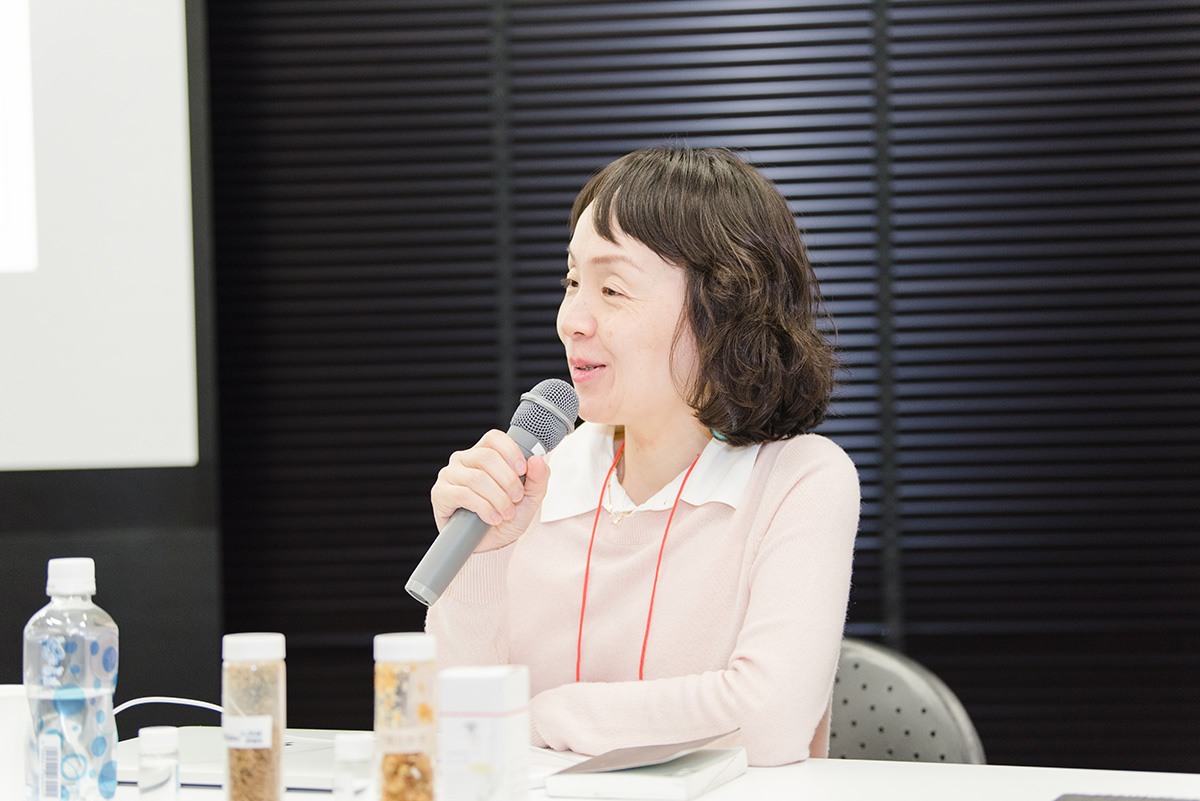
Since the theme of this session today was unutilized resources, I would like to talk about what we have been working on recently, and what we are doing very well is minor grains. Minor grains such as rice bran, millet, millet, and millet yield functional oil. We are currently looking for outlets for this oil. Recently, we have been fermenting various raw materials, not only rice, to make ethanol, which is then used as a product. Furthermore, we are also adding more and more value to the lees. We are also working with local people to reduce waste to zero by, for example, putting chicken droppings into rice paddies and fields.
We are also doing tours and events to attract people to the area, so we are trying to get more money out of it.
Some of you may be thinking, "Isn't it a bit unprofitable as a business? Some people may think that it is not a profitable business. However, the market needs now are for small quantities, variety, and customization of food, general merchandise, and cosmetics. I believe this will never change. We are not trying to make a big product at a low price, but rather, we are trying to provide original raw materials according to our customers' needs.
Our core technology has three strengths: the first is know-how. Rather than intellectual property, we can optimize various raw materials and make products tailored to each outlet. The second is equipment. With the cooperation of RIVERNESS, we would like to take this further, using the wisdom of local factories. We are not in the business of making and selling products in large quantities, so we cannot do this using equipment that is normally sold. So we would like to make small, highly mobile equipment that meets the needs of our customers. Finally, our third strength is our expertise in creating new markets on our own, without leaving the exit to others when commercializing a business. Recently, the world has become a place where things like SDGs and recycling are essential, and we want to respond to your needs.
One last initiative I would like to talk about is one that we just released: JR East is making apple liquor. The process produces dozens of tons of lees per year, which are fermented and distilled to make ethanol. This ethanol is then fermented and distilled to produce ethanol, which is then used to make fashionable products. We are planning to sell the products through Lumine and JR's sales channels starting next Monday.
The name "Pharmen Station" means "fermentation station," and with your help, we would like to increase the number of stations that utilize such unused resources. So, I would like to talk with those who have raw materials and those who have outlets. That's all.
imperial palace
Yes, thank you. You have many very, very interesting products. I am looking forward to hearing more about this story, and I hope that new products will be born as well.
Creating jobs in rural areas, the way agriculture should be.
imperial palace
Next, Mr. Kusano of Agri-Mito will introduce himself.
Yuichi Kusano, Agri-Mito
Hello everyone. My name is Kusano of Agri-Mito Ltd. I am from Masuda City in Shimane Prefecture. I would like to exchange opinions with you and absorb a lot of things to bring back home with me.
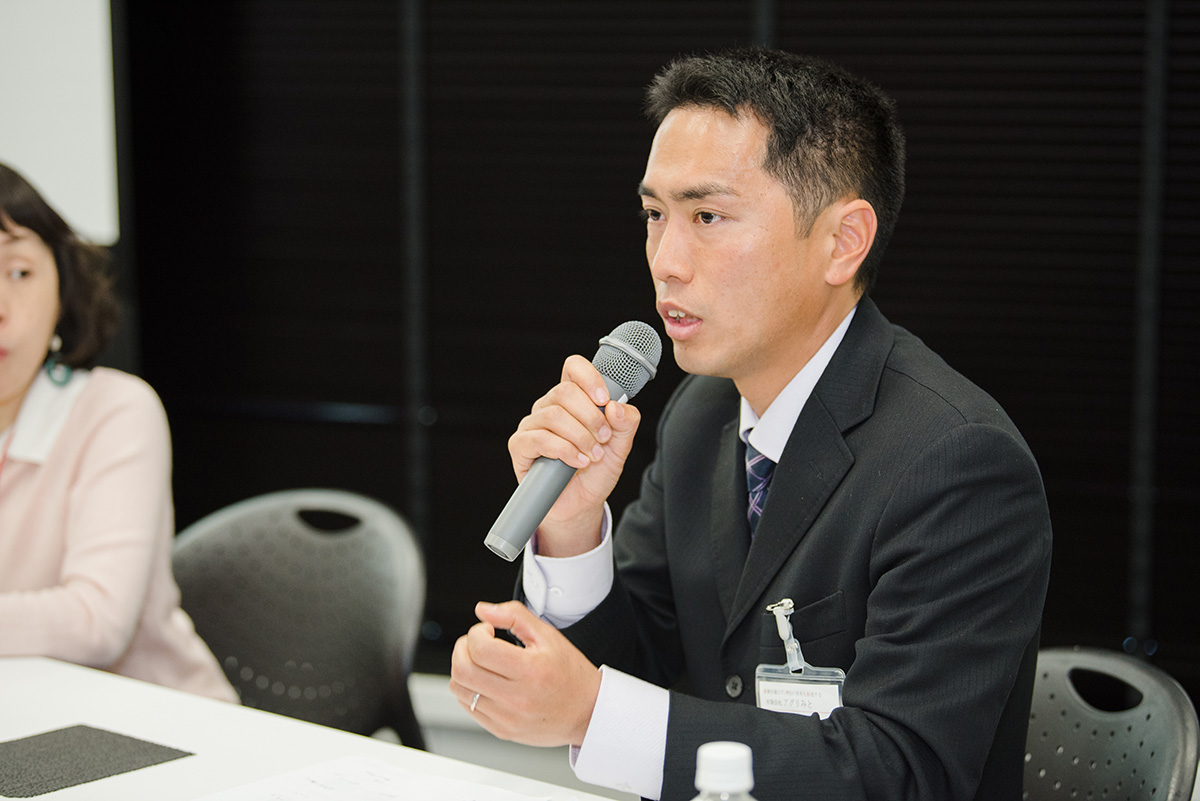
Masuda City is located in the western part of Shimane Prefecture and has a population of 47,000. The aging rate is 36%, which is the same as in any other rural area. Fortunately, however, the airport is within 15 minutes of the city. There are two flights a day to and from Tokyo, so I think convenience is good. The Takatsu River, which is the clearest river in Japan, is located in the city, so I think it is a good area with clean water. I am engaged in agriculture in this area. Agri Mito Ltd. is located about 15 minutes by car from the city in the mountains. Since the rice fields are also located in the mountains, it is not possible to grow each rice field large, so it is difficult to grow something on a large scale like field crops in order to improve management efficiency and increase profits.
In addition, since we are located on the Japan Sea side, in the shadow of the mountains, it snows during the winter. This makes it difficult to grow crops in winter and produce goods throughout the year. Therefore, if we want to make a profit, we need to grow crops with high profit per area, such as tomatoes and strawberries. That is why we are producing strawberries.
Strawberries are grown and harvested on a raised platform for better workability. Since we have expanded our cultivation area this year, we need to improve the efficiency of cultivation. Strawberries are harvested from December to nearly June, after which we make seedlings, plant them in September, and harvest them again in December, so we have to work all year round. In order to reduce the time and effort required to make seedlings, we are trying to eliminate this work by growing strawberries directly on the cultivation bench while making the seedlings.
Aside from strawberries, baby leaves are another popular vegetable. This is a very popular vegetable because it is very easy to eat. We grow baby leaves throughout the year. We harvest and sort the baby leaves that have sprouted from seeds planted in the ground. We employ local retired women for a short time in the morning to sort and ship them.
Also, rice. Normally, the rice production in the rice paddies ends there, but in our case, we grow narcissus bulbs after the rice production is finished. After the rice is harvested in September or October, we plow the fields and plant the bulbs immediately after the rice harvest. After the bulbs are dug up, the fields are plowed and planted again. When things are going well, we make rice twice and bulbs once in two years. We try to cultivate the fields as profitably as possible without letting the fields rest.
I believe that by creating some kind of work for a year in this way, employment will be created in the local community, and in this way, a system will be established for people to work. Since Mashida is a mountainous area and there is no expressway in the city, it is difficult to attract companies to the area and increase employment. Fortunately, the population is decreasing and the number of farmers is also decreasing, so there are plenty of fields left over. We are thinking about how we can utilize these fields to protect the community.
Today, we will be discussing the effective use of unused resources, and I am sure that after this exchange of opinions, we will be able to find something that can be utilized to make it more exciting.
imperial palace
Yes, thank you, Mr. Kusano. I would very much appreciate it if you could tell us how unused resources can be used from a producer's point of view.
Challenges facing local agriculture
imperial palace
Now, I would like to get right into the theme of the session.
First, I would like to ask you all, what are some of the challenges of agriculture in the region?
Let me ask Mr. Kusano. Earlier, you commented that it is difficult to grow on a large scale in mountainous areas.
grasslands
One of the challenges facing local agriculture is the difficulty of achieving large-scale production, and the aging of the population means that there are few bearers. When I think about why there are so few bearers, it is not only because of the small population, but also because there are not many people in the community who want to make a living from agriculture. The parents' generation who were engaged in farming went through hardships themselves, so I think that more and more people do not want their children to go through such hardships and stay in the community to do it. I think that is why the number of farmers is not increasing.
There is also the waste that inevitably comes out of farming. For example, it is often said that cabbage is grown but the weather is too good, so it is better to dispose of it than to ship it. For example, there are cases in which the weather is too good for cabbage, and it is better to dispose of the cabbage than to ship it. In some cases, the rice is not fully utilized. I believe that if we can create a profitable system for agriculture by making good use of such discarded materials, it will become an attractive industry. This will increase the number of bearers of agriculture, and if a system can be established to make a living in the region, people will come back to live in the countryside.
imperial palace
Thank you. I guess you are saying that garbage is still not being utilized very well in agriculture. When you say that you are throwing it away, do you mean that you are spreading it on the fields?
grasslands
In the case of rice hulls, they are not decomposed as they are, so even if they are spread in the field, they will interfere with the growth of the crops. In order to decompose them, they take nitrogen from the husks. If you want to prevent this, you end up leaving a pile of rice husks in the field. Rice bran is relatively easy to decompose once it is spread, so there are ways to utilize it, but when it comes to rice husks, it is very difficult to utilize.

imperial palace
I see. Thank you very much. Mr. Sakai, I know that you are often in contact with producers, but are there any issues that are unique to the Tohoku region?
sake well
I don't know if this is unique to the Tohoku region, but the average age of the people in the villages we work with is around 70, and there are no young people. When I meet with young farmers' groups, there are of course some groups that are very enthusiastic, but they have problems with sales channels.
I also feel that many people have no contact with people from outside the industry. What I think I am able to do is to invite people who have nothing to do with agriculture, such as cosmetics and general merchandise, and let them know about the outside industry. Through such encounters, we can learn that this is a good way to do things, or that our production methods can be marketed in this way, or that sales channels can open up from unexpected sources. I think there are many areas where interaction is lacking.
imperial palace
I see. Thank you very much. Mr. Sakai, is there any particular reason why you first decided to start in Tohoku?
sake well
I quit finance to study fermentation at Tokyo University of Agriculture. The laboratory I belonged to at that time decided to do joint research with Oshu City in Iwate Prefecture, and I became a member. So when I went there, there were already members who were very motivated. People often ask me, "Was it difficult for you to join? But I had no difficulty at all.
Bamboo processed by a planted cilium is used for agriculture.
imperial palace
Let me ask Mr. Kayaba. I have heard that people in various regions are using planting machines, but how are they actually used in local agriculture?
thatched-roof grave
In many cases, planting machines are installed in municipalities. They are used by local governments to process prunings from parks, roadside trees, and households, which were previously disposed of as general waste, into a humus-like state by passing them through the planting machine. In western Japan, it seems that bamboo and other materials are often processed.
imperial palace
Mr. Kusano mentioned earlier that rice husks are difficult to decompose, but are there examples of processing rice husks?
thatched-roof grave
Yes, we do. The planting machine has also been installed in a rice center run by JA. There was a large amount of rice husks lying around at the rice center. In the past, the rice husks were given to local livestock farmers as a moisture conditioner. However, the husks did not absorb much moisture as they were. When the rice husks are processed by a weeder, they absorb more moisture and retain water better. In addition, fermentation also goes more smoothly.
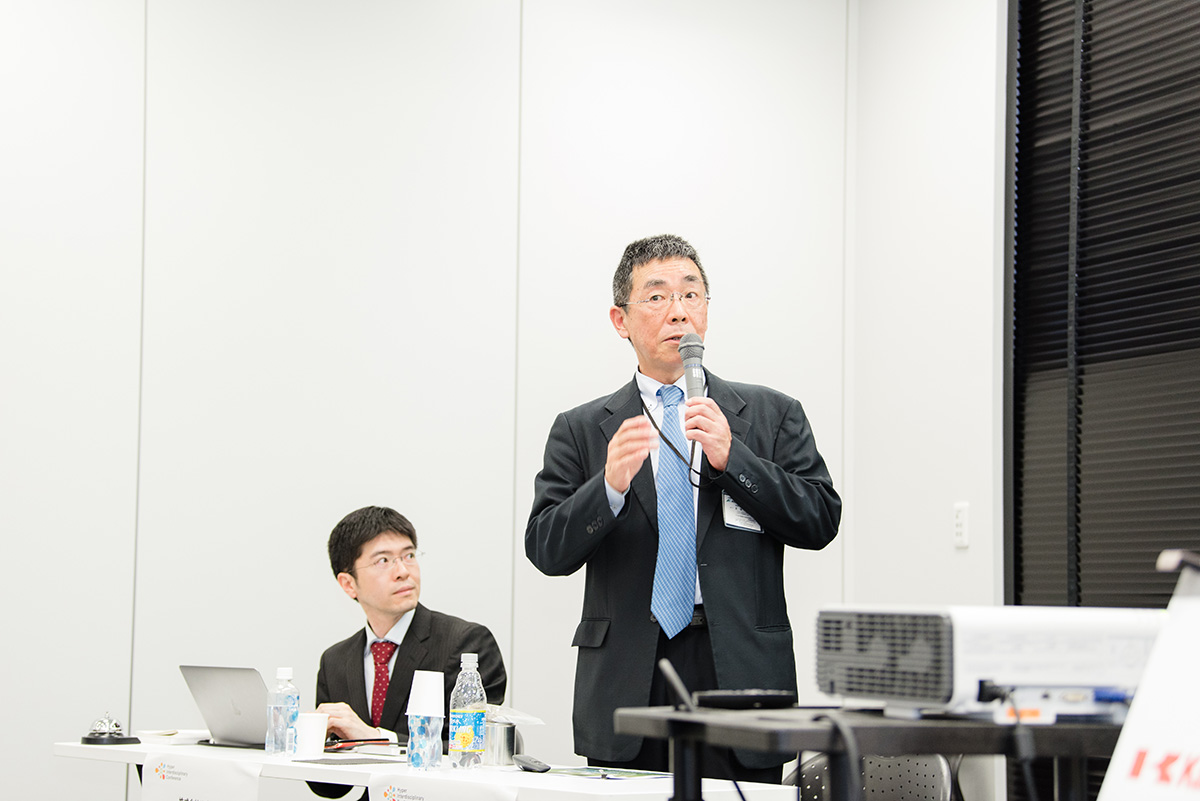
imperial palace
I see that you are also making progress in utilizing the rice husks against rice husks. You mentioned bamboo earlier. I would like to ask you, Mr. Kusano, are bamboos really troublesome?
grasslands
Once bamboo grows, its roots spread out. It grows fast and gets bigger and bigger. Maybe it would still be good if we could dig up the bamboo shoots. In fact, the situation quickly becomes a bamboo grove, and people can no longer enter. When that happens, we may suffer from wild boars and other bird and animal damage. I wonder if bamboo disposal will be necessary to protect the mountain.
imperial palace
Thank you very much. So there is, in fact, harm caused by bamboo. How about your place, Mr. Sakai? I hear rumors that there is not much bamboo in Tohoku.
sake well
No, there are. Some people say, "Well, this is tricky, it's a challenge," but I don't know how big it is. I get bamboo shoots every year. Oh, bamboo can be used to make ethanol.
imperial palace
Kayaba, you also mentioned that bamboo contains polysaccharides. Are there people who actually ferment bamboo and use it for something?
sake well
In the ethanol industry, there is probably a lot of talk about using bamboo as a raw material. I think there are some people who are conducting demonstration experiments. In that case, I think that the crushing and decomposition of the bamboo would be quite a bottleneck. That's why I'm interested in the bamboo cultivator. I would like to try it.
imperial palace
Then, by all means, try crushing bamboo with a weeder and fermenting it. I think you will get interesting results.
sake well
Yes, it could work. I would like to try.
imperial palace
Do you receive any inquiries about actually making alcohol products at your place, Kayaba?
thatched-roof grave
Yes, we do. We sometimes receive such stories. Today, I have bamboo that has been processed by a fiber-planter and stored in a can for about three weeks. I don't know what's inside, but would you like to open it?
imperial palace
We encourage you to try it out. Please pass the opened ones around the hall. You were just talking about bamboo, but I think there are many other unused resources lying dormant in the community. I would like to ask you, Mr. Sakai, do you have any consultation on the use of unused resources in various communities?
sake well
Yes, we get a lot of inquiries. We get a lot of inquiries about tomato stems, unusable parts of wasabi, berries, and other agricultural products that can no longer be sold once they are slightly damaged. There are also stories about sea squirts and other products. When you get to this point, it doesn't matter a little bit about sugar or ethanolization. Among these, we have actually done apples, plums, peaches, persimmons, melons, watermelons, and a variety of vegetables.
imperial palace
You've been hit pretty hard.
sake well
That's right. I thought it would be a shame to turn down the offer, and I might come up with something interesting. For now, we are considering sending some raw materials to us and conducting simple laboratory tests. We are keeping it in our database. Then, when we propose products such as regular ethanol or distillation lees, we can say, "We have something like this, too. We have recently been collecting only wild grape seeds. Recently, we have even received requests to collect only wild grape seeds.
imperial palace
I see. I would like to ask you, Mr. Kusano, from a producer's standpoint, what unused resources are there in your area?
grasslands
Yuzu is a specialty in my area. The pruned branches of these yuzu trees are thrown out as garbage. Yuzu branches are very thorny. JA also makes and sells yuzu vinegar, and there is also residue from that. Some of it is used to feed livestock, and the clean part is used for processing, but I think it would be good if we could utilize this kind of yuzu waste. Also, in my case of strawberries, there are trees left after harvest. If I mix them into the field as they are, they can cause diseases, so I take them out of the field. If I can break them up into small pieces and use them as compost instead of chemical fertilizers, I think it would be possible to create a form of circulation and sustainable agriculture.
imperial palace
I would like to see how much the decomposition of those unutilized resources would be different if we use a fiber-planter. Do you have any data on the difference between the materials that were subjected to a fiber-planter and those that were not subjected to a fiber-planter?
thatched-roof grave
A major reason for the inclusion of tree-planting machines in municipalities is the recycling of street tree pruning. Street trees range from hardwoods to softwoods. Especially for coniferous trees, the local government used to shred or pulverize them and put them into farmland, but they sometimes caused damage because they did not rot even after many years. So, it seems that the farmers did not like them. However, when even coniferous trees are treated with the pulverizer, they become easy for microorganisms to attach to them, and they rot without problems.
imperial palace
Is there any problem if I actually sow it in the field? I would like to know what happens when it is spread. For example, do you have any data on the results of processing bamboo or residues with a weeder and spreading them on farmland?
thatched-roof grave
It's not really data, but we have actually had people come to us who use the bamboo treated by the planting machine for agriculture and we have had them deliver what they are actually making.
We have strawberries from Date City in Fukushima Prefecture, Dekopon from Ehime Prefecture, and rice from Tottori. We hope you will enjoy them.
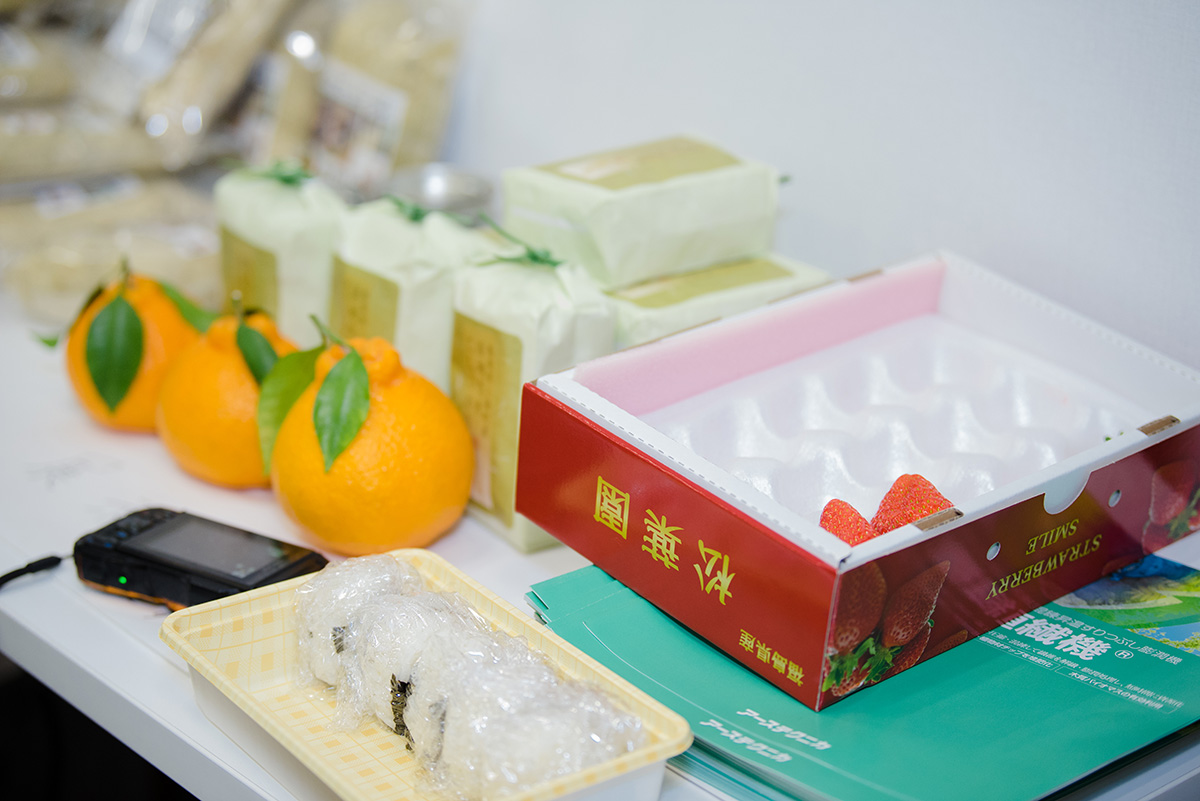
imperial palace
Let's eat some. I'm also interested in Kusano-san's evaluation of strawberries.
Mr. Kayaba, I would like to ask you one more question: have you heard any changes from the farmers who used those bamboo treatments?
thatched-roof grave
There are many farmers who grow fruit trees, and there is one who grows Sato Nishiki cherries in Yamagata in the north, and another who grows mangoes in Kagoshima in the south. I don't know the details, but I think it raises the sugar content. Also, the soil. Bamboo itself has almost no fertilizer content. However, I think that by placing it in the soil, the microbiological properties of the soil will be improved.
imperial palace
I see, the sugar content of the fruit and the microflora of the soil. How do you guys use the bamboo treatments in your fields? Do you stir it into the fields or just sprinkle it on the surface? If it is just sprinkled, it seems like it would be easy to start.
thatched-roof grave
For example, a farmer who grows rice uses it wrapped around the surface instead of plowing it into the soil. The reason is that they use the treated bamboo in its raw form without fermenting it. If we plow it into the soil, it will cause nitrogen starvation and gas disorders, so we use it in the form of placing it on top of the soil. On the contrary, it is hassle-free and easy to use.
imperial palace
Thank you very much. It looks very easy to do.
Mr. Kusano, how do you feel about the products you brought us? Kayaba-san is very interested in them.
grasslands
First of all, the strawberries, which had probably been in the market for three or four days to reach this point, had a firm flesh, and the aroma had a strong aftertaste. Also, the sweetness of the fruit was also present, which is not unusual this time of year, as the nutrients are taken away by the strawberry trees. I thought that the strawberry trees must have been cultivated in a healthy state while being kept alive.
imperial palace
Thank you very much. It looks like the bamboo powder can be spread and used right away...would you like to give it a try?
grasslands
Yes, I agree. It is difficult to do it all out of the blue, but it is good to try a trial with just one row. In the case of strawberries, I think you can see the results right away, so I think it would be interesting to compare the taste of the berries and the way the trees stand.
imperial palace
I'm excited to see the good results. You mentioned that you also do baby leaves, but do you have any examples of using bamboo powder in leafy greens?
thatched-roof grave
I know a farmer who grows baby leaves. That farmer doesn't seem to have a continuous crop failure of baby leaves. The yield and shelf life are also good. That's a wonder, and he seems to be invited to give lectures at various places. So I think it must have some effect on leafy vegetables as well.
imperial palace
I see, is continuous crop damage and longevity an issue with baby leaves? Mr. Kusano.
grasslands
Yes, baby leaf is a process of seeding, harvesting, plowing, and seeding again. If the crop is not growing well, the crop will continue to deteriorate, and there is a possibility that the crop will remain diseased. In such a situation, I think it is good for the grower that there is little chance of continuous crop failure. As for longevity, baby leaf is a race against time. The longer it takes for them to be transported to the store and sold, the more they shrivel up, or in the worst case, the more they melt inside. Therefore, if the shelf life is improved even by one day, the loss will be reduced. I think the buyers will be more pleased if they can eat them even after a few days.
imperial palace
Okay, it would be interesting to see if bamboo powder actually improves row crop failure and day length.
I know you are growing rice, but I wonder if sprinkling bamboo powder on your rice would make any difference.
sake well
Yes, I would like to talk to the farmers. However, in our case, there is an issue: we have JAS organic certification, which is based on the concept of increasing soil fertility and production that does not rely on chemical fertilizers, but we are only allowed to use ingredients that have been clearly explained to us. If we want to use something new, we have to provide a lot of proof that there is no problem with it. That's why we want to use local resources to make soil, but that makes things more complicated. However, we can handle it ourselves, but it is also difficult to put in the equipment to make that happen on a farmer-by-farmer basis. I am interested in this.
imperial palace
Kayaba, do you have any examples of people who are actually JAS certified and use bamboo powder?
thatched-roof grave
The truth is that when it comes to JAS certification, it is actually difficult to obtain.
imperial palace
I see, so we need to think of another way.
How to use unused resources to expand their potential?
imperial palace
I would like to hear more about the utilization of various unused resources. I understand that you use apple pomace as fertilizer. Do you feel that unused resources are difficult to use, or do you feel that they should be used locally? You have successfully overcome various obstacles and have come to the point of using the lees as livestock feed, haven't you?
sake well
Yes, we took the same approach to feed conversion as we did to ethanol as a raw material for cosmetics, and we started from the exit. It was especially easy to do with chickens because we had a nearby chicken farmer who was willing to cooperate with us. However, we had a hard time with cows. Cattle are priced in the millions per head range, so many people are resistant to the challenge of something new. The place where our factory is located is famous for Maesawa beef, but Maesawa beef has a fixed formula feed, so what if we use something different and end up with strange cattle? So we have not been able to use it for many years now.
In the midst of all this, we were approached by a cattle farmer who wanted to try something new. There was a young farmer who wanted to produce a stable supply of good feed using local and unused resources.
After the farmers ship the beef, it is slaughtered in Shinagawa, for example, and then there is a vendor who slaughters the beef. There is a woman in that company, and she, the farmers, and we have been working together to make this happen. The problem was that cattle feed cannot be simply produced; it has to be mixed in a variety of ways. There happened to be a compound feed store near our factory that specialized in cattle feed, and they were able to provide us with custom-made feed. This is an example of how we were finally able to realize the feeding of cattle in such a way.
We had to think of a way out for the cows we created, so last year we purchased a half of a cow through crowdfunding. We really wanted to buy a whole cow. I think this is also very important. Cattle are in high demand for specific parts, but you can buy various parts in bulk. We put together a variety of parts and sold them to the general public as a beef grab bag for 5,000 yen. We offered the public a variety of parts for 5,000 yen as a kind of "beef goody bag." We didn't know which parts they would receive, but we told them that it was delicious meat produced through regional circulation. This initiative actually became a hot topic in the cattle industry, and we felt that it might work, so we would like to do it again in the future.
imperial palace
I thought such efforts were being done more, but it is actually something new.
sake well
That's right. The division between the people who use cattle and the places where they are produced is probably quite large. Restaurants often say, "Just give us this part of the cow.

imperial palace
I see. As for the bamboo powder, are there any examples of using it as livestock feed?
thatched-roof grave
We have tested it as roughage. A professor who was at Hiroshima University at the time conducted a feeding test of bamboo treated with a weeder. Also, Kagoshima University of Agriculture has been researching the silaging of bamboo treated with a silicon fiber weeder.
imperial palace
I see, so data is accumulating in the research field.
Masuda City is also quite active in livestock farming, isn't it? Is it popular to use crop residues for livestock farming?
grasslands
In Masuda, we are engaged in poultry farming and cattle breeding. There is a place that makes tofu, so we use the bean curd from that as feed for the cattle, and for the yuzu I mentioned earlier, we also use the peelings as feed. I think it is good for ranchers to be able to utilize locally produced products, as imported feed is becoming more expensive.
imperial palace
I see. You mentioned that bamboo could be used as a fertilizer for crops and as roughage for livestock when it is passed through a weeder. Bamboo, an unused resource, could be used to feed cattle, and the manure from the cattle could be used as fertilizer for local agriculture. I think such a recycling-oriented model could be drawn up. What do you think, Kayaba-san?
thatched-roof grave
Today I told you that bamboo treated with a planting fiber machine is used in the agricultural field. And through today's session, I think there are other possibilities. The canned bamboo powder I mentioned earlier, it smelled a little like alcohol, didn't it? This is an aroma that does not usually come out in this kind of crushing and grinding process. Normally, you don't want to smell it. In other words, I think that processing with a fiber-planter has a different effect from the usual crushing and pulverizing. I feel that this is where the potential of this machine lies.
imperial palace
Thank you. I am sure we will find out more interesting things as we demonstrate the system in the future. One of the first demonstrations will be at Agri Mito in Masuda, and since RIVANES also raises cattle in Masuda, I think we can try using the system there as well.
Finally, I would like to ask all the speakers to tell us what kind of people they would like to work with and what kind of research they would like to do in the future when considering the utilization of unutilized resources. There are a variety of researchers here, so please feel free to interact with them after the session.
Now let's hear from Mr. Kayaba.
thatched-roof grave
Thank you for attending this session today. Earth Technica has a factory in Yachiyo City, Chiba Prefecture. We have a demonstration machine in the plant, so if you have unused resources that you would like to use for the machine, or if you know someone who does, please let us know. We would like to accumulate data while processing various materials not only in Japan but also overseas.
imperial palace
Thank you very much. If you have something you want to pulverize, go to Yachiyo, right?
Next, how about Mr. Sakai?
sake well
I have a lot to say. First of all, Mr. Kayaba, we have something we would like to pulverize, so let us discuss this separately. We are looking for researchers who are strong in microorganisms and who are interested in analyzing, detecting, and searching for functional properties. Besides that, we are also considering the use of ethanol as an ingredient in food products and supplements. It would be great if you could share your ideas and challenges with us. We are already full up with consultations on the entrance to unused resources, so we would like to hear about that as a possibility for the future. And we are also looking for companies and others who are interested in products born from our sustainable efforts. Also, we are currently looking for full-time and part-time workers and supporters. Please contact us if you are interested, even if it is online.
imperial palace
Thank you very much. By the way, how many people were doing this now?
sake well
Right now we have three and a half people coming to Iwate and two more to Tokyo, but we are not short at all, so we are recruiting.
imperial palace
I understand. I would be happy to talk with anyone who has any questions that apply to me.
Lastly, Mr. Kusano, please.
grasslands
Since we are on the producer side, we are always on the lookout for new technology, but it is difficult to get such technology. Farmers tend to hide their technologies from each other, so if you are a researcher and have a technology you would like to demonstrate in the field, we would be happy to do so.
I also believe that it could be used in the medical field as an added value to agriculture. For example, the ingredients of agricultural products may be amazing, and I believe that the activity of agriculture itself, which brings people into contact with nature, may extend people's life spans. In this sense, I believe that the cutting edge is in the countryside. If there is anyone who is interested in experimenting with a new form of Japan in the countryside, I would be happy to work together with them. Thank you very much for your time today.
grasslands
Thank you very much. If you want to demonstrate, please come to Masuda. Rivanes has already started in Masuda.
Thank you very much for your time today. I hope that from here we can expand our circle of cooperation.

Environmental Sales Section, Sales Department, Earth Technica Inc.
Kayaba Tokio(Mr. Tokio Kayaba
The company manufactures a swelling processor (brand name - "Planting Fiber") as a technology for recycling herbaceous material, and is developing facilities for recycling pruning branches for municipalities. The herbaceous material is compressed, kneaded, defibered, and heated to change its properties. The company is aiming to develop this technology as a pre-processing technology for the utilization of bamboos and alianthus.

Representative Director, Furumen Station Co.
Rina Sakai(Mr. Rina Sakai
The company is developing a regional recycling system to produce ethanol and distillation lees from unused resources. Rice-derived organic ethanol and distillation lees are sold to major cosmetics manufacturers as raw materials for cosmetics and sundries, and original products are planned and sold to major select stores. The company is developing a small-scale, self-sustainable regional recycling system with zero waste, both domestically and internationally. Currently, rice is the raw material, but in the future, the company aims to create a platform for value-added products by using a variety of raw materials.
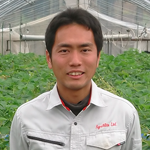
Agri Mito Ltd.
Yuichi Kusano(Mr. Yuichi Kusasa
Agri Mito" is an agricultural production corporation that produces and sells agricultural products such as strawberries, baby leaves, paddy rice, daffodils, and eggplants, mainly in Mito Town, Masuda City, Shimane Prefecture. Because agricultural production is conducted in a mountainous area, it is difficult to improve management efficiency through large-scale production. In addition, the winter season has little sunlight and snowfall, which is unique to the San-in region, making it difficult to produce crops year-round and to provide year-round employment. Under these circumstances, the company is developing agricultural production in mountainous areas using strawberries, which have high yield and can be cultivated in winter.

Director, Research and Development Division and Agri-Garage Research Institute, Liverness, Inc.
Yosuke Miyauchi(Yosuke Miyanouchi)
During his master's and doctoral studies, he traveled to Xinjiang Uygur Autonomous Region to establish high-yield soybean cultivation technology with local researchers under the research theme of "Development of high-yield soybean cultivation technology in arid regions in China. At RIVANES, he is using his research experience to conduct research on the cultivation of space soybeans and domestic wheat Yumechikara with elementary, junior high, and high school students. Currently, he promotes joint research with companies and ventures at the Agri-Garage Research Institute in Sumida-ku, Tokyo.

